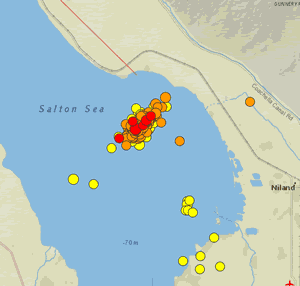Extending a jaw-dropping stretch of rapid intensification, Hurricane Matthew has become the Atlantic's first Category 5 hurricane since Felix in 2007. Matthew's top sustained winds were set at 160 mph in the 11 pm EDT update from the National Hurricane Center. The upgrade was based on radiometer-measured near-surface winds as high as 143 knots (165 mph] gathered in a Hurricane Hunter flight on Friday evening. Now located less than 100 miles north of the Colombian coastline, Matthew continues to move just south of due west at about 7 mph.Earlier today:
Matthew is the planet’s fifth Category 5 storm of the year. The others were Tropical Cyclone Winston, which devastated Fiji in the Southwest Pacific in February; Tropical Cyclone Fantala from May, in the Southwest Indian Ocean; Super Typhoon Nepartak from July, in the Northwest Pacific Ocean; and Super Typhoon Meranti in the Northwest Pacific, which struck the small Philippine island of Itbayat Island while at peak strength in September. Super Typhoon Meranti was the most intense Category 5 of the year, with sustained winds of 185 mph and a central pressure of 890 mb. The globe averages between 4 and 5 Category 5 storms per year.
In records going back to 1924, only five Atlantic hurricanes are on record as having Category 5 strength this late in the year--all of them in the Caribbean, the region where sufficiently warm waters and favorable atmospheric conditions are most likely to occur this late in the season. Shown with their date spans at Category 5 strength, these are:
"Cuba": October 19, 1924More background from our earlier post
"Cuba": November 5-8, 1932
Hattie: October 30-31, 1961
Mitch: October 26-28, 1998
Wilma: October 19, 2005
There's been little change so far in the outlook for Matthew, although we'll be watching tonight's 00Z Saturday model runs closely to see what comes next. Below is more context on Matthew's past, present, and future, mostly brought over from our post earlier this afternoon. We will be posting regular updates through the weekend, typically between 10 am and noon EDT and between 6 and 8 pm EDT. For those new to our blog, the comments section is packed with valuable insights from our many members, including meteorologists as well as dedicated laypeople.
Bob Henson and Jeff Masters
How did Matthew get so strong so quickly?
Vertical wind shear of up to 20 knots has plagued Matthew for most of the last two days, yet the storm has not only maintained its structure but grown at a ferocious rate. Dissertations may be written on how this happened! Working in Matthew’s favor has been a steadily moistening atmosphere along its westward path, which means that the shearing winds didn’t push too much dry air into Matthew. Once it developed a central core, Matthew was able to fend off the wind shear much more effectively. In addition, water temperatures are unusually warm throughout the Caribbean (and the entire western North Atlantic), with an area of high oceanic heat content directly beneath Matthew’s path. Such deep oceanic heat allows a storm to strengthen without churning up cooler waters from below that could blunt the intensification....MUCH MORE
Hurricane Matthew Rapidly Intensifies
Wednesday
Hurricane Watch: "Tropical Storm Matthew Forms in the Lesser Antilles Islands"
Ensemble of storm track models:





